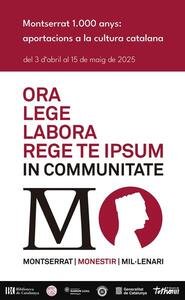
Montserrat 1,000 years: Contributions to Catalan culture / exhibitions / visit us / start
The Library of Montserrat, in collaboration with the Library of Catalonia and the Ramon Llull University, presents this exhibition to commemorate the Miliariumthe milestone that indicates 1,000 steps on the long path of Benedictine presence in Montserrat.
We celebrate it making a trip through decisive moments in the cultural history of the monastery, which today is projected to a second millennial life full of illusions, challenges and new projects.
We are talking about monastic life in Montserrat, which began with the flights of 1025 with the Foundation for the Abbot Oliba of a primitive church dedicated to Santa Maria, depending on Ripoll. We briefly review the spiritual references of the Benedictine monks, always present in the Library of Montserrat.
We are talking about the arrival of Father García Jiménez de Cisneros to the monastery in 1493, when, at the request of Ferdinand the Catholic, Pope Alexander VI incorporated Montserrat into the Castilian congregation of Valladolid. The monastery experienced a period of restoration of the monastic community and also the establishment of an incunabula printing company in 1499. Using the “new wonderful art of writing”, bulls, liturgy books and spirituality were printed.
Let’s talk about the Escolania de Montserrat, Documented since the fourteenth century, when children sang during religious offices to praise the Virgin of Montserrat. We highlight the contributions of some teachers and the restoration of the Escolania, at the end of the 19th century, thanks to the pedagogical renewal promoted by monks such as parents Jacint Boada and Manuel Guzmán and continued in the 20th century by Father Ireneu Segarra.
Let’s talk about Father Bonaventura Ubach, who, in the twentieth century, promoted the project to translate the Bible to Catalan and the creation of a museum in Montserrat.
Let’s talk about the Montserrat Library, Over the years he has gathered a rich bibliographic collection thanks to the efforts of the monks and the generous donations, among which we emphasize the valuable contribution of the patron Rafael Patxot of the Fund l ‘Work of the popular songbook of Cataloniathe donation and study of papyri by Dr. Roca-Puig and the Catalan cartography collection by the Gasset-Marcet family.
We are talking about the participation of the Library of Montserrat in the collective catalog of the universities of Catalonia, with the help of the Ramon Llull University, which marked the beginning of a new stage in the dissemination of knowledge.
Finally, we talk about the interest of the monastic community in nature as a space of solitude and silence, and study in the fields of botany and meteorology.








